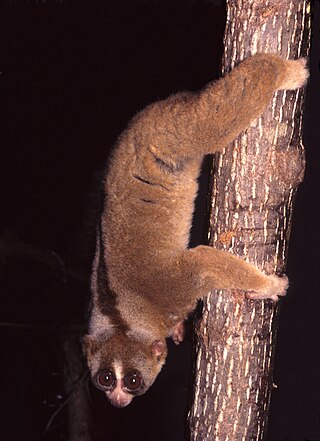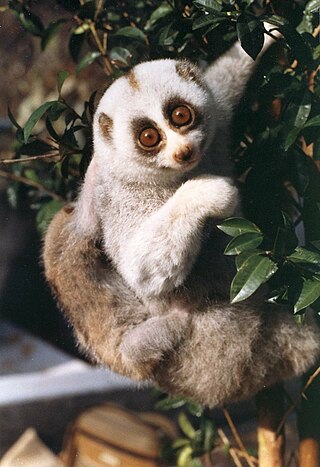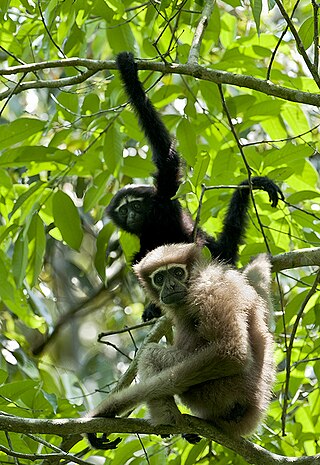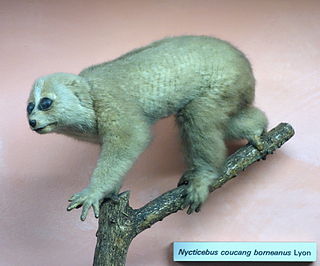
Lorisidae is a family of strepsirrhine primates. The lorisids are all slim arboreal animals and comprise the lorises, pottos, and angwantibos. Lorisids live in tropical, central Africa as well as in south and southeast Asia.

Loris is the common name for the strepsirrhine mammals of the subfamily Lorinae in the family Lorisidae. Loris is one genus in this subfamily and includes the slender lorises, Nycticebus is the genus containing the slow lorises, and Xanthonycticebus is the genus name of the pygmy slow loris.

Slow lorises are a group of several species of nocturnal strepsirrhine primates that make up the genus Nycticebus. Found in Southeast Asia and nearby areas, they range from Bangladesh and Northeast India in the west to the Sulu Archipelago in the Philippines in the east, and from Yunnan province in China in the north to the island of Java in the south.

The Sunda slow loris, or greater slow loris, is a strepsirrhine primate and a species of slow loris native to Indonesia, West Malaysia, southern Thailand and Singapore. It measures 27 to 38 cm from head to tail and weighs between 599 and 685 g. Like other slow lorises, it has a wet nose (rhinarium), a round head, small ears hidden in thick fur, a flat face, large eyes and a vestigial tail.

The pygmy slow loris is a species of slow loris found east of the Mekong River in Vietnam, Laos, eastern Cambodia, and China. It occurs in a variety of forest habitats, including tropical dry forests, semi-evergreen, and evergreen forests. It was originally classified within Nycticebus until it was transferred to the genus Xanthonycticebus in 2022. Two species are recognised, the northern pygmy loris X. intermedius from northern Vietnam, Laos and China and the southern pygmy loris X. pygmaeus from southern Vietnam, Laos and Cambodia. The animal is nocturnal and arboreal, crawling along branches using slow movements in search of prey. Unlike other primates, it does not leap. It lives together in small groups usually with one or two offspring. An adult can grow to around 19 to 23 cm long and has a very short tail. It weighs about 450 g (1.0 lb). Its diet consists of fruits, insects, small fauna, tree sap, and floral nectar. The animal has a toxic bite, which it gets by licking a toxic secretion from glands on the inside of its elbows. The teeth in its lower jaw form a comb-like structure called a toothcomb that is used for scraping resin from tree bark.

The Bengal slow loris or northern slow loris is a strepsirrhine primate and a species of slow loris native to the Indian subcontinent and Indochina. Its geographic range is larger than that of any other slow loris species. Considered a subspecies of the Sunda slow loris (N. coucang) until 2001, phylogenetic analysis suggests that the Bengal slow loris is most closely related to the Sunda slow loris. However, some individuals in both species have mitochondrial DNA sequences that resemble those of the other species, due to introgressive hybridization. It is the largest species of slow loris, measuring 26 to 38 cm from head to tail and weighing between 1 and 2.1 kg. Like other slow lorises, it has a wet nose (rhinarium), a round head, flat face, large eyes, small ears, a vestigial tail, and dense, woolly fur. The toxin it secretes from its brachial gland differs chemically from that of other slow loris species and may be used to communicate information about sex, age, health, and social status.

The slender lorises (Loris) are a genus of loris native to India and Sri Lanka. The genus comprises two species, the red slender loris found in Sri Lanka and the gray slender loris from Sri Lanka and India. Slender lorises spend most of their life in trees, traveling along the tops of branches with slow and precise movements. They are found in tropical rainforests, scrub forests, semi-deciduous forests, and swamps. The primates have lifespans of approximately 15 years and are nocturnal. Slender lorises generally feed on insects, reptiles, plant shoots, and fruit.

The Javan slow loris is a strepsirrhine primate and a species of slow loris native to the western and central portions of the island of Java, in Indonesia. Although originally described as a separate species, it was considered a subspecies of the Sunda slow loris (N. coucang) for many years, until reassessments of its morphology and genetics in the 2000s resulted in its promotion to full species status. It is most closely related to the Sunda slow loris and the Bengal slow loris (N. bengalensis). The species has two forms, based on hair length and, to a lesser extent, coloration.

The Hollongapar Gibbon Sanctuary, formerly known as the Gibbon Wildlife Sanctuary or Hollongapar Reserved Forest, is an isolated protected area of evergreen forest located in Assam, India. The sanctuary was officially constituted and renamed in 1997. Set aside initially in 1881, its forests used to extend to the foothills of the Patkai mountain range.

The Borneo lowland rain forests is an ecoregion, within the tropical and subtropical moist broadleaf forests biome, of the large island of Borneo in Southeast Asia. It supports approximately 15,000 plant species, 380 bird species and several mammal species. The Borneo lowland rain forests is diminishing due to logging, hunting and conversion to commercial land use.

The Philippine slow loris is a strepsirrhine primate and a species of slow loris that is native to the north and east coastal areas of the island of Borneo, as well as the Sulu Archipelago in the Philippines. The species was first named as the Bornean slow loris in 1892, but lumped into the widespread Sunda slow loris (N. coucang) in 1952. However, it was promoted to full species status – again as the Bornean slow loris – based on molecular analysis in 2006. In 2013, two former subspecies of the Bornean slow loris were elevated to species status, and a new species—N. kayan—was recognized among the Bornean population.
? Nycticebus linglom is a fossil strepsirrhine primate from the Miocene of Thailand. Known only from a single tooth, an upper third molar, it is thought to be related to the living slow lorises, but the material is not sufficient to assign the species to Nycticebus with certainty, and the species name therefore uses open nomenclature. With a width of 1.82 mm, this tooth is very small for a primate. It is triangular in shape, supported by a single root, and shows three main cusps, in addition to various crests. The absence of a fourth cusp, the hypocone, distinguishes it from various other prosimian primates.

Slow lorises are nocturnal strepsirrhine primates in the genus Nycticebus that live in the rainforests of South and Southeast Asia. They are threatened by habitat loss and fragmentation from deforestation, selective logging, and slash-and-burn agriculture, as well as by collection and hunting for the wildlife trade, including the exotic pet trade, and for use in traditional medicine and as bushmeat. Because of these and other threats, all five species of slow loris are listed as either "Vulnerable" or "Endangered" by the International Union for Conservation of Nature (IUCN). Their conservation status was originally listed as "Least Concern" in 2000 because of imprecise population surveys and the frequency in which these primates were found in animal markets. Because of their rapidly declining populations and local extinctions, their status was updated and in 2007 the Convention on International Trade in Endangered Species of Wild Fauna and Flora (CITES) elevated them to Appendix I, which prohibits international commercial trade. Local laws also protect slow lorises from hunting and trade, but enforcement is lacking in most areas.

The Kayan River slow loris is a strepsirrhine primate and a species of slow loris that is native to the northern and central highland region of the island of Borneo. The species was originally thought to be a part of the Bornean slow loris (N. menagensis) population until 2013, when a study of museum specimens and photographs identified distinct facial markings, which helped to differentiate it. It is distinguished by the high contrast of its black and white facial features, as well as the shape and width of the stripes of its facial markings.

The Bangka slow loris is a strepsirrhine primate and a species of slow loris that is native to southwestern Borneo and the island of Bangka. Originally considered a subspecies or synonym of the Bornean slow loris (N. menagensis), it was promoted to full species status in 2013 when a study of museum specimens and photographs identified distinct facial markings, which helped to differentiate it as a separate species. It is distinguished by the crimson red fur on its back, light-colored facial features, as well as the shape and width of the stripes of its facial markings.

Nycticebus borneanus, the Bornean slow loris, is a strepsirrhine primate and a species of slow loris that is native to central south Borneo in Indonesia. Formerly considered a subspecies or synonym of N. menagensis, it was promoted to full species status in 2013 when a study of museum specimens and photographs identified distinct facial markings, which helped to differentiate it as a separate species. It is distinguished by its dark, contrasting facial features, as well as the shape and width of the stripes of its facial markings.
The Bornean slow loris is a strepsirrhine primate and a species of slow loris that is native to Borneo in Indonesia.















